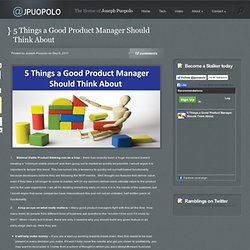

The Yin and Yang of Product and Engineering. For a tech company, product and engineering are the heart and soul of the business.

When I do a quick mental query of headcount across our entire portfolio of ~30 companies, I think at least 50% and maybe as much as 60% of the entire headcount of our portfolio is in either product or engineering. Many of the founding teams we back include a strong coder and a strong product person. A typical configuration is the founding CEO is also the "VP Product" at the start. This is a great configuration for a starting team. The two individuals can and should build a tight knit relationship with each focusing on their particular roles in getting the product built. As the company scales the yin and yang of product and engineering often gets out of whack.
I have seen many companies go through this phase. The prescription for these problems is two fold. Collecting best practices. Reading through emails and blogs yesterday afternoon I came to posts from engineers at Disqus and Twitter via Fred Wilson’s Code is craft post.

I read them partly because Fred recommended them and partly because I was interested to hear what presumably talented engineers at successful services like Disqus and Twitter had to say about improving the speed of a service and identifying the root cause of service problems respectively. I’m interested to read these stories not because I am ever likely to need to do something similar myself (I am nowhere near that technical) but because I need to be able to recognise a good engineer when I see one. That helps with figuring out whether we should invest in a company and in hiring senior techies into our existing portfolio companies.
I had two takeaways from the Disqus post: First, always proceed from the general to the specific And second, live by the data, but don’t trust it. Product Leadership Series: Creating a Great Product Process at O. Product Leadership Series: Creating a Great Product Process at Opower May 25, 2010 This is my second post in my product leadership series.

Today I’m chatting with Ben Foster, VP product at Opower. For those who don’t know the company, Opower is a fast growing energy efficiency software company that helps utilitiesmotivate consumers to reduce energy usage. What Makes A Great Product Leader? - robgo.org. What Makes A Great Product Leader? April 12, 2010 There was some chatter a few weeks ago about the dearth of experienced product managers in innovation centers outside of Silicon Valley. It’s definitely true in the East Coast, and it hurts both very early stage companies (where the founder is usually the product leader) and scaling companies that need to bring on additional PM talent over time. Good product manager, bad product manager. The 3 Skillsets that Make Successful Product Managers. “When a project goes well, the engineering team was brilliant.

When it fails, that meddlesome PM sabotaged everything… ”- An anon sr. engineer at Google Being a Product Manager is tough. Succeeding is even harder. Over the last year, as I’ve taken on the responsibilities of managing a team of PMs I’ve been forced to think deeply about the skills that make successful PMs. Cognitive Overhead, Or Why Your Product Isn’t As Simple As You Think. Editor’s Note: David Lieb is co-founder and CEO of Bump, creators of the popular app that lets people share contact information, photos, and other content by bumping their phones together.

Bump has been downloaded more than 130 million times. It’s been hard to ignore the massive shift in the last decade toward simple products. The minimalist design aesthetic pioneered by Dieter Rams in the 1960s on alarm clocks and toasters was popularized by Apple and Google in the 2000s on iPods and search boxes. Soon after, Web 2.0 took over, yielding big buttons, less text, more images, and happier users. Startup accelerators and design gurus popped up proselytizing “simplicity!”
This Ain’t Is Your Grandma’s Internet So why did this happen, and why mostly in the last 10 years? But I believe the high-order bit is even more straightforward: It’s only been in the last 10 years that technology products have reached the mass market. “Simple” Isn’t What You Think But “simplicity” comes in many flavors. Product Strategy Means Saying No. If you’re building a product, you have to be great at saying No.

Not ‘maybe’ or ‘later’. The only word is No. The visionary’s lament. 5 Things a Good Product Manager Should Think About. 1.

Minimal Viable Product thinking can be a trap – there has recently been a huge movement toward creating a “minimum viable product” and then going out to market as quickly as possible. I would argue it is important to temper this trend. This has turned into a tendency to quickly roll out half-baked functionality because developers believe they are following the MVP mantra. Well thought out features that deliver value, even if they take a bit longer to come to market, will (in my opinion) deliver more ultimate value to the product and to the user experience. I am all for iterating something early on once it is in the hands of the customer, but I would argue that some companies have misconstrued this and roll out an untested, half written piece of functionality 2.
It will help make money – If you are a start-up working towards break-even, then this needs to be ever present in every decision you make. 3. 4. 5. Google: What makes someone a great product manager at Google. Why Product Managers Need Sneakers.